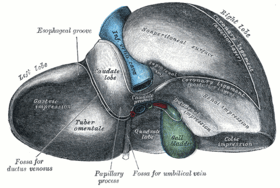Bare area of the liver
| Bare area of the liver | |
|---|---|
 Vertical disposition of the peritoneum. Main cavity, red; omental bursa, blue (bare area of the liver labeled at right, second from the top) | |
 The liver, as seen from behind. The bare area is visible on the upper-right, labeled as nonperitoneal surface | |
| Details | |
| Identifiers | |
| Latin | Area nuda hepatis |
| FMA | 14480 |
The bare area of the liver (nonperitoneal area) is a large triangular surface of the liver devoid of peritoneal covering.
The coronary ligaments represent reflections of the visceral peritoneum covering the liver onto the diaphragm. As such, between the two layers of the coronary ligament lies the bare area of the liver, and is attached to the diaphragm by areolar tissue.
The bare area of the liver is still covered by Glisson's capsule, the fibrous capsule that sheathes the entire liver.
Clinical significance
The bare area of the liver is clinically important because it represents a site where infection can spread from the abdominal cavity to the thoracic cavity.
References
This article incorporates text in the public domain from the 20th edition of Gray's Anatomy (1918)
Additional Images
-
Bare area of the liver.Diaphragmatic surface of liver.
External links
- Anatomy photo:38:10-0201 at the SUNY Downstate Medical Center - "Stomach, Spleen and Liver: Ligaments of the Liver"
- liver at The Anatomy Lesson by Wesley Norman (Georgetown University)